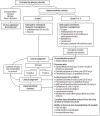Management of hypersensitivity to platinum- and taxane-based chemotherapy: cepo review and clinical recommendations
- PMID: 25089112
- PMCID: PMC4117628
- DOI: 10.3747/co.21.1966
Management of hypersensitivity to platinum- and taxane-based chemotherapy: cepo review and clinical recommendations
Abstract
Background: Although antineoplastic agents are critical in the treatment of cancer, they can potentially cause hypersensitivity reactions that can have serious consequences. When such a reaction occurs, clinicians can either continue the treatment, at the risk of causing a severe or a potentially fatal anaphylactic reaction, or stop the treatment, although it might be the only one available. The objective of the present work was to evaluate the effectiveness of methods used to prevent and treat hypersensitivity reactions to platinum- or taxane-based chemotherapy and to develop evidence-based recommendations.
Methods: The scientific literature published to December 2013, inclusive, was reviewed.
Results: Premedication with antihistamines, H2 blockers, and corticosteroids is not effective in preventing hypersensitivity reactions to platinum salts. However, premedication significantly reduces the incidence of hypersensitivity to taxanes. A skin test can generally be performed to screen for patients at risk of developing a severe reaction to platinum salts in the presence of grade 1 or 2 reactions, but skin testing does not appear to be useful for taxanes. A desensitization protocol allows for re-administration of either platinum- or taxane-based chemotherapy to some patients without causing severe hypersensitivity reactions.
Conclusions: Several strategies such as premedication, skin testing, and desensitization protocols are available to potentially allow for administration of platinum- or taxane-based chemotherapy to patients who have had a hypersensitivity reaction and for whom no other treatment options are available. Considering the available evidence, the Comité de l'évolution des pratiques en oncologie made recommendations for clinical practice in Quebec.
Keywords: Hypersensitivity reactions; chemotherapy; desensitization; management; platinum salts; skin testing; taxanes.
Figures


References
LinkOut - more resources
Full Text Sources
Other Literature Sources
Research Materials

